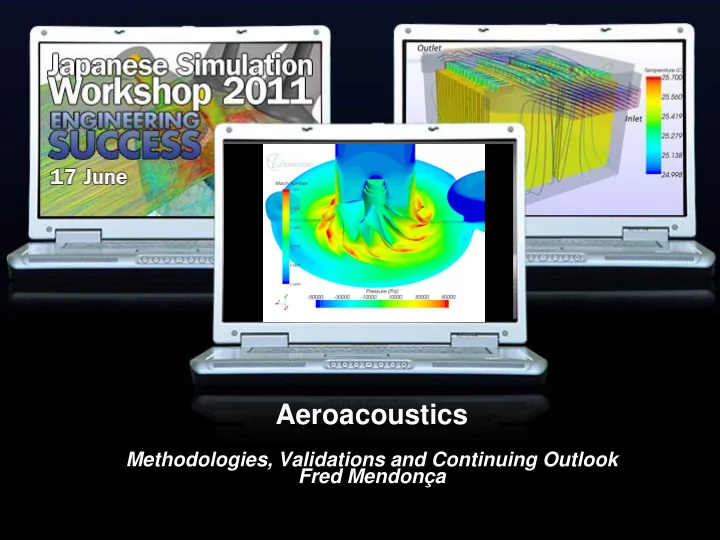

Aeroacoustics Your title goes here Methodologies, Validations and Continuing Outlook Your subtitle goes here Fred Mendonça
Some Characteristic Flow Noise Issues • Autom omotiv otive e – extern ernal, al, sunroof of buffet eting, ing, HVAC • Aerospace – airframe noise, jets, ECS
Industry and Expert Collaborations DESTINY Aeroacoustics Projects (2002 - 2005) – German Auto manufacturers – Aeroacoustics Working Group (2005-7 – and 2009-11) Daimler, BMW, Audi, VW, Porsche » Acoustic partner collaborations – LMS through BEM codes SYSNOISE and V.Lab.Acoustics » FFT’s FEA code, ACTRAN » ESI’s SEA code, VA -One » Aero-Vibroacoustics – External flow excitation, internal structural noise transmission » Internal flow excitation, external structural noise transmission » One of the originators in the field, Paul Bremner, expert advisor to CD-adapco » LES for Acoustics, Cambridge University Press – http://www.cambridge.org/us/catalogue/catalogue.asp?isbn=0521871441
Introduction – CFD, with the correct physical models…. » Is very capable of simulating the sources of aeroacoustic noise Directly (LES) for applications in the low Reynolds number range - Indirectly (RANS) using broadband syntesization models - » Also possible to propagate the noise – STAR-CCM+ provides the software tools to extract the maximum value from the CFD process in Aeroacoustics CAE » Dedicated Training programme for Aeroacoustics – CD-adapco sees as its responsibility to deliver the validated tools, with the best-practice advice; stating value and limitations
Aeroacoustics Overview: v6.04 and beyond Ae Aeroacous roacoustics ics Sim Simula lations ions Optio ions ns Steady ady state Transient ansient Synt nthe hesized ized Broad oadban band d LES LES Fluc uctua uatio ions ns SNGR Correla rrelatio ions ns DES LEE LEE CURLE surf rfac ace Trans ansien ient RANS Lille ley PROUDMAN AN volume lume Point int and d Surface FFTs GOLD LDST STEI EIN 2D-ax axi Expor port to Auto o and Cross Spectra ra – cohere herenc nce e and phas ase Propa opagat gation ion codes des FW FW-H Mesh Freque equenc ncy Cut-off Direc ect Export ort to ACTRAN AN / V.Lab ab.Ac Acou oustics ics / VA-One One Direc ect Noise e Propa opaga gatio ion Direc ect Export ort to SEA for r inter ernal nal nois ise e charac haracter eris isatio ion
Process Steady-state: Model Optimisation – Source Locations (Broadband correlations, Lilley, Curle, Proudman) » Mesh requirements (Mesh frequency cut-off estimator) » Assess time-step requirements » – Transient: Direct Source Capture Advanced turbulence models » Advanced boundary conditions » Compressible solutions » Direct Propagation (in STAR-CCM+) – Propagation via coupling to: – 250 Hz 500 Hz 1000 Hz 2000 Hz SYSNOISE / V.Lab.Acoustics » FFT-ACTRAN » VA-One » VibroAcoustics transmission via SEA, FEA –
Steady-state: Broadband correlations for AAC sources Quadrupole-like sources re-synthesized from steady-state RANS result – STAR 1 st commercial CFD code to introduce Lilley source visualisation (2000) – Curle surface noise correlation – Proudman volume correlation – Locates maximum noise – sources quickly Adds value for – Parametric design changes » Locates regions for mesh refinement » Locates regions for data output »
Steady-state: Broadband correlations - Examples Surface (Curle) Volume (Proudman)
Steady-state: Mesh Frequency Cut-off Estimator – Unique to STAR – Estimates the resolvable frequency from steady-state results – Informs user of CFD grid suitability early in the process – E.g. Frequency of up to1000Hz in mirror wake example
Transient capabilities LES-type turbulence model – DES (options of Spalart-Allmaras, k- ε, k - ωSST ) » DES advection scheme blending » Full LES (wall resolved or unresolved) » Advanced wall treatment – y+ insensitive » Non-reflecting conditions for – Inflow and outflow boundaries » Full Compressibility – Interaction between the flow and acoustics » Especially for cavity resonance - Most efficient commercial transient solver – 2 nd order space and time discretisation » Spectral Analysis – » FFT at points and surfaces Auto and Cross spectra – coherence and phase » Frequency and Wave Number Fourier analysis »
Validated Methodology Monitor point in mirror wake – STAR Experiment Tail-off in predicted spectrum at mesh cut-off frequency of ~1000 Hz –
Validated Methodology Surface FFT (dB) at 500Hz (top) and 1000Hz (bottom)
Direct Propagation in STAR-CCM+ – Mesh requirement » 20 cells per acoustic wavelength ( λ = c / f ) In ambient conditions, you need cells of ~15mm to propagate a signal at - 1000Hz Domain size = 1000D, (~10 λ ) - – Non-reflective in/outflow boundaries
Propagation – FW-H and 3 rd party code export STAR results capture the acoustic sources for propagation via – Ffowcs Williams-Hawkings (far-field propagation of compact sources » without internal reflections) STAR offers coupling to 3 rd party propagation codes: – FFT, ACTRAN 500 0 Hz » 100 0 Hz LMS, Virtual.Lab.Acoustics » ESI, VA-One » VibroAcoustics – Using FVS in STAR-CCM+ » Export to SEA and FEA » 3150 50 Hz Over erall all
Industrial examples with Validations Resonance Effects – Slat / Cavity /Flap – HVAC duct: Dipole Sources – Fan Noise – S ide-view mirror: External Aero – AIAA Aeroacoustics Benchmarks (2009) – END
Thank you Aeroacoustics – Validated methodologies and Outlook
Recommend
More recommend